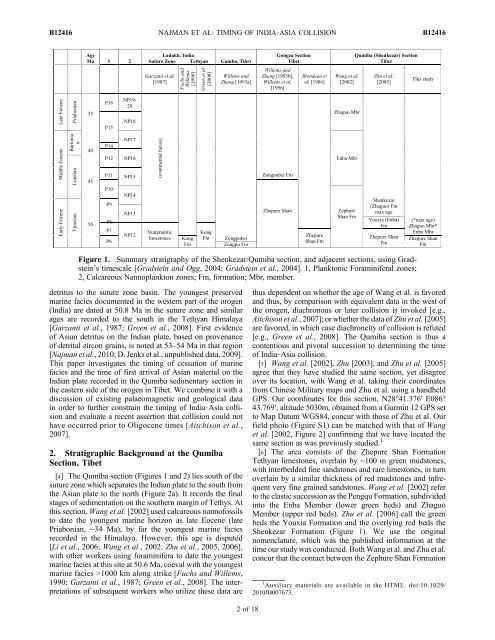Timing of IndiaâAsia collision: Geological, biostratigraphic, and ...
Timing of IndiaâAsia collision: Geological, biostratigraphic, and ...
Timing of IndiaâAsia collision: Geological, biostratigraphic, and ...
Create successful ePaper yourself
Turn your PDF publications into a flip-book with our unique Google optimized e-Paper software.
B12416<br />
NAJMAN ET AL: TIMING OF INDIA‐ASIA COLLISION<br />
B12416<br />
Figure 1. Summary stratigraphy <strong>of</strong> the Shenkezar/Qumiba section, <strong>and</strong> adjacent sections, using Gradstein’s<br />
timescale [Gradstein <strong>and</strong> Ogg, 2004; Gradstein et al., 2004]. 1, Planktonic Foraminiferal zones;<br />
2, Calcareous Nannoplankton zones; Fm, formation; Mbr, member.<br />
detritus to the suture zone basin. The youngest preserved<br />
marine facies documented in the western part <strong>of</strong> the orogen<br />
(India) are dated at 50.8 Ma in the suture zone <strong>and</strong> similar<br />
ages are recorded to the south in the Tethyan Himalaya<br />
[Garzanti et al., 1987; Green et al., 2008]. First evidence<br />
<strong>of</strong> Asian detritus on the Indian plate, based on provenance<br />
<strong>of</strong> detrital zircon grains, is noted at 53–54 Ma in that region<br />
[Najman et al., 2010; D. Jenks et al., unpublished data, 2009].<br />
This paper investigates the timing <strong>of</strong> cessation <strong>of</strong> marine<br />
facies <strong>and</strong> the time <strong>of</strong> first arrival <strong>of</strong> Asian material on the<br />
Indian plate recorded in the Qumiba sedimentary section in<br />
the eastern side <strong>of</strong> the orogen in Tibet. We combine it with a<br />
discussion <strong>of</strong> existing palaeomagnetic <strong>and</strong> geological data<br />
in order to further constrain the timing <strong>of</strong> India‐Asia <strong>collision</strong><br />
<strong>and</strong> evaluate a recent assertion that <strong>collision</strong> could not<br />
have occurred prior to Oligocene times [Aitchison et al.,<br />
2007].<br />
2. Stratigraphic Background at the Qumiba<br />
Section, Tibet<br />
[4] The Qumiba section (Figures 1 <strong>and</strong> 2) lies south <strong>of</strong> the<br />
suture zone which separates the Indian plate to the south from<br />
the Asian plate to the north (Figure 2a). It records the final<br />
stages <strong>of</strong> sedimentation on the southern margin <strong>of</strong> Tethys. At<br />
this section, Wang et al. [2002] used calcareous nann<strong>of</strong>ossils<br />
to date the youngest marine horizon as late Eocene (late<br />
Priabonian, ∼34 Ma), by far the youngest marine facies<br />
recorded in the Himalaya. However, this age is disputed<br />
[Li et al., 2006; Wang et al., 2002; Zhu et al., 2005, 2006],<br />
with other workers using foraminifera to date the youngest<br />
marine facies at this site at 50.6 Ma, coeval with the youngest<br />
marine facies >1000 km along strike [Fuchs <strong>and</strong> Willems,<br />
1990; Garzanti et al., 1987; Green et al., 2008]. The interpretations<br />
<strong>of</strong> subsequent workers who utilize these data are<br />
2<strong>of</strong>18<br />
thus dependent on whether the age <strong>of</strong> Wang et al. is favored<br />
<strong>and</strong> thus, by comparison with equivalent data in the west <strong>of</strong><br />
the orogen, diachronous or later <strong>collision</strong> is invoked [e.g.,<br />
Aitchison et al., 2007]; or whether the data <strong>of</strong> Zhu et al. [2005]<br />
are favored, in which case diachroneity <strong>of</strong> <strong>collision</strong> is refuted<br />
[e.g., Green et al., 2008]. The Qumiba section is thus a<br />
contentious <strong>and</strong> pivotal succession to determining the time<br />
<strong>of</strong> India‐Asia <strong>collision</strong>.<br />
[5] Wang et al. [2002], Zhu [2003], <strong>and</strong> Zhu et al. [2005]<br />
agree that they have studied the same section, yet disagree<br />
over its location, with Wang et al. taking their coordinates<br />
from Chinese Military maps <strong>and</strong> Zhu et al. using a h<strong>and</strong>held<br />
GPS. Our coordinates for this section, N28°41.376′ E086°<br />
43.769′, altitude 5030m, obtained from a Garmin 12 GPS set<br />
to Map Datum WGS84, concur with those <strong>of</strong> Zhu et al. Our<br />
field photo (Figure S1) can be matched with that <strong>of</strong> Wang<br />
et al. [2002, Figure 2] confirming that we have located the<br />
same section as was previously studied. 1<br />
[6] The area consists <strong>of</strong> the Zhepure Shan Formation<br />
Tethyan limestones, overlain by ∼100 m green mudstones,<br />
with interbedded fine s<strong>and</strong>stones <strong>and</strong> rare limestones, in turn<br />
overlain by a similar thickness <strong>of</strong> red mudstones <strong>and</strong> infrequent<br />
very fine grained s<strong>and</strong>stones. Wang et al. [2002] refer<br />
to the clastic succession as the Pengqu Formation, subdivided<br />
into the Enba Member (lower green beds) <strong>and</strong> Zhaguo<br />
Member (upper red beds). Zhu et al. [2006] call the green<br />
beds the Youxia Formation <strong>and</strong> the overlying red beds the<br />
Shenkezar Formation (Figure 1). We use the original<br />
nomenclature, which was the published information at the<br />
time our study was conducted. Both Wang et al. <strong>and</strong> Zhu et al.<br />
concur that the contact between the Zephure Shan Formation<br />
1 Auxiliary materials are available in the HTML. doi:10.1029/<br />
2010JB007673.

















